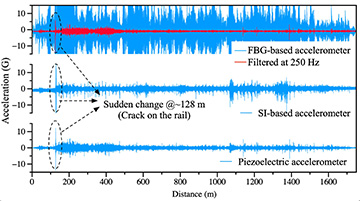![]()
In the accelerometer, when a vibration occurs, the mass block presses on the coiled photonic-crystal fiber at a frequency matching that of the vibration, causing the wavelength of light in the fiber to shift in a measurable way. [Image: The Hong Kong Polytechnic University]
Networked accelerometers can monitor trains for troublesome vibrations that could lead to a derailment, but current models have issues with sensitivity or shielding. A research team in Hong Kong has developed a tiny accelerometer, incorporating a photonic-crystal fiber, that exhibits greater sensitivity over a wider frequency range than older designs (Opt. Express, doi:10.1364/OE.27.021597).
Building the accelerometer
The accelerometer from the Hong Kong Polytechnic University incorporates a Sagnac interferometer, in which counter-propagating light beams pass through a ring or spiral path. Movement of the interferometer introduces a phase shift into the interference fringes coming off of the device.
In this case, the scientists built the interferometer out of a commercially available polarization-maintaining photonic-crystal fiber (PM-PCF), bent into a spiral 15 mm in diameter and coupled to a single-mode fiber for input and output. A steel substrate supports the device, which is mounted onto a cylindrical mass block that transfers vibrations from the vehicle to the fiber.
Both in the laboratory and on a railway train, the researchers tested their device against two other types of accelerometers: a piezoelectric model, which requires electromagnetic shielding, and a device based on fiber Bragg gratings, which cannot detect vibrations at frequencies greater than 500 Hz. (Track wear—a significant cause of railroad accidents—usually generates vibration frequencies higher than that.) The PM-PCF instrument performed comparably to its piezoelectric cousin, whereas the grating-based device picked up lots of noise due to its low resonant frequency.
Stabilizing the signal
Measured acceleration using accelerometers based on (from top to bottom): fiber Bragg grating, polarization-maintaining photonic crystal fiber and piezoelectric technologies. [Image: The Hong Kong Polytechnic University] [Enlarge image]
Stabilizing the sensing signal after installing the accelerometer on the railway train was the biggest challenge to the Hong Kong Polytechnic team, says lead researcher Zhengyong Liu, a senior research fellow at the university's Photonics Research Center. The researchers learned that the optical signal used to detect the vibration could change due to improper movements of the unit during transportation and installation on the train.
To overcome this problem, Liu's team used strong epoxy to bond all of the components including the PM-PCF. “During the fabrication of the accelerometer,” Liu explains, “we also came up with an approach to keep one polarization axis of the PM-PCF coiled in one plane so that the sensing signal of the accelerometer is with less polarization cross talk.”
Future updates
In the future, Liu and his group will replace the commercial photonic-crystal fiber with a higher-sensitivity fiber that they fabricated in their own laboratory, and then repeat the field tests with the upgraded accelerometer. The researchers must also verify the repeatability of the fabrication technique before mass production of the devices can begin.
The team also wants to fit multiple accelerometers in a single strand of a transmission fiber. According to Liu, fiber-based accelerometers are considered superior to piezoelectric accelerometers because of fiber's multiplexing capability over long distances. “In our prospective research investigations,” he says, “we intend to effectively multiplex and de-multiplex sensing signals so that multiple accelerometers can be used simultaneously in the fiber sensing system.” Finally, since a sensing system with multiple fiber-based accelerometers will acquire millions of data points, the university is developing artificial intelligence technologies to handle the information.

